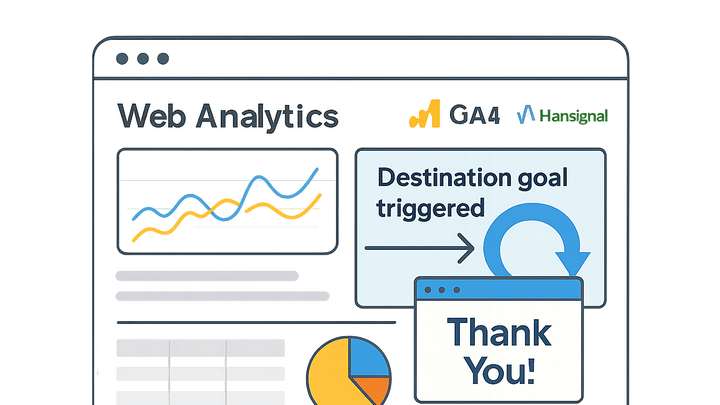Published on 2025-06-27T22:37:38Z
What Is a Destination in Analytics? Examples with PlainSignal and GA4
Destination in analytics refers to a specific page or screen that signifies the successful completion of a user action (e.g., checkout confirmation, thank-you page, or form submission). When a visitor reaches this endpoint, the analytics platform records a conversion event. Configuring destination goals is essential for measuring campaign effectiveness, optimizing conversion funnels, and understanding user behavior. Platforms such as Google Analytics 4 (GA4) and PlainSignal offer built-in features to define destination triggers using page URLs or custom events. By tracking destinations, marketers can quantify ROI, refine marketing strategies, and identify drop-off points in the user journey. In the sections below, we explain the concept, its importance, and walkthrough setups in GA4 and PlainSignal.
Destination
A destination is a conversion goal triggered when a user reaches a specific URL or event, tracked in GA4 and PlainSignal.
What Is a Destination?
A destination is the URL or screen that marks the end of a desired user journey. It acts as a goalpost for conversions, indicating that a user has completed an action you care about, such as purchasing, signing up, or downloading. Tracking destinations helps you quantify success and pinpoint which channels or campaigns drive the most valuable traffic.
-
Url-based destination
Triggers a conversion when a user lands on a specific URL, like
/thank-youor/order-complete. You can match the URL exactly, use ‘begins with’, or apply regular expressions for more flexibility.-
Exact match
The URL must match exactly (e.g.,
https://example.com/thank-you). -
Begins with
Any URL that starts with a given string triggers the goal (e.g.,
https://example.com/checkout). -
Regex match
Use regular expressions to capture multiple patterns (e.g.,
/thank\-you|order\-complete/).
-
-
Event-based destination
Some platforms treat a destination as an event. For example, GA4 logs a
page_viewevent with apage_locationparameter. You can mark that event as a conversion when it meets certain criteria.-
Page_view event
GA4 automatically collects
page_viewevents; you can define a condition onpage_locationto flag it as a conversion.
-
Why Destinations Matter
Destinations are the cornerstone of conversion tracking. They help you understand how effectively your site or campaign drives users toward key actions and where improvements are needed.
-
Measure success
Quantify conversions to evaluate campaign ROI, optimize ad spend, and set performance benchmarks.
-
Optimize funnels
Identify drop-off points in the user journey and refine UX or messaging to boost completion rates.
-
Inform marketing decisions
Use destination data to allocate budget toward high-performing channels and refine targeting strategies.
Setting Up a Destination in GA4
Google Analytics 4 uses events rather than traditional goal definitions. You can mark specific
page_view events as conversions by creating custom event rules.
-
Enable enhanced measurement
In GA4 Admin > Data Streams, ensure Enhanced Measurement is toggled on to automatically collect
page_viewevents. -
Create a custom conversion
Define a new event based on
page_viewwith a condition onpage_location, then mark it as a conversion.-
Step 1: open events
Navigate to Admin > Events.
-
Step 2: create event
Click Create event, set
Event nametopage_view, and add a matching condition likepage_location contains '/thank-you'. -
Step 3: mark as conversion
Go to Admin > Conversions and toggle on your new custom event.
-
Setting Up a Destination in PlainSignal
PlainSignal offers a simple, cookie-free approach. You define URL rules in the dashboard to count conversions when visitors reach your destination paths.
-
Install PlainSignal script
Add the PlainSignal tracking snippet to every page of your site.
-
Script tag
Embed the snippet in your
<head>as shown below.
-
-
Define a destination goal
In the PlainSignal dashboard, go to Goals and create a new rule matching your destination URL.
-
Url rule builder
Select ‘Path equals’ and enter your destination (e.g.,
/thank-you). -
View conversions
Monitor goal completions under the Goals section in PlainSignal.
-
Example Tracking Code
Below are code snippets for PlainSignal and GA4 to capture page views and destination events.
-
PlainSignal tracking code
<link rel="preconnect" href="//eu.plainsignal.com/" crossorigin /> <script defer data-do="yourwebsitedomain.com" data-id="0GQV1xmtzQQ" data-api="//eu.plainsignal.com" src="//cdn.plainsignal.com/plainsignal-min.js"></script> -
GA4 tracking code
<!-- Google Analytics Global Site Tag --> <script async src="https://www.googletagmanager.com/gtag/js?id=G-XXXXXXXXXX"></script> <script> window.dataLayer = window.dataLayer || []; function gtag(){dataLayer.push(arguments);} gtag('js', new Date()); gtag('config', 'G-XXXXXXXXXX'); </script>
